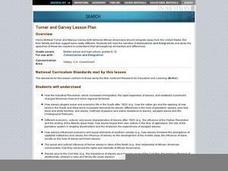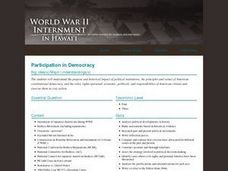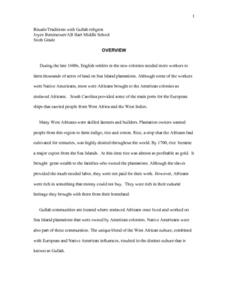Curated OER
Breaking Barriers
Students investigate racism in the 20th century by exploring U.S. History. In this Civil Rights lesson, students review the history of slavery, the Civil War and the fight for equality in the mid 1900's. Students complete Civil Rights...
Curated OER
Unit 2: Post-Revolution: The Critical Period 1781-1878
The post-Revolutionary Period of 1781-1787, also known as the Critical Period, is the focus of a series of lessons that prompt class members to examine primary source documents that reveal the instability of the period of the Articles of...
Curated OER
Double V Campaign: Victory at Home and Victory Abroad
Students write a persuasive essay as if they were an African American in World War II and decide if they would contribute war bonds or not. In this World War II lesson plan, students study the segregation of World War II and the unity...
Curated OER
Cattle Trails
In this cattle trails study guide worksheet, learners read about the American West. Students read 4 sections of information.
Albert Shanker Institute
Economic Causes of the March on Washington
Money can't buy happiness, but it can put food on the table and pay the bills. The first of a five-lesson unit teaches pupils about the unemployment rate in 1963 and its relationship with the March on Washington. They learn how to create...
Curated OER
African American Emigration: Turner and McNeal
Learners discuss reasons why African Americans may have wanted to emigrate from the United States followig the Civil War. They complete a Venn diagram noting the differences between proposals by Marcus Garvey and Henry McNeal Turner.
Stanford University
Observing Human Rights Day
How much intervention is appropriate for America to take in cases of human rights violations? Class members ponder a question that has lingered since the birth of America with a series of primary sources that reflect the degree to which...
Curated OER
Attitudes Toward Emancipation
Students read the Emancipation Proclamation and investigate steps that led to its signing. They read and discuss period news articles from both sides of the argument and create portfolios of documentation supporting both sides.
Curated OER
P.O.W.: Products of War
Tenth graders are introduced to concepts of war through musical lyrics. They demonstrate and understanding of the role of segregation in US military policy and practice.
Curated OER
Free Market Labor vs. Slave Labor
Students summarize support for free market labor vs. slave labor in antebellum America. They explain how existing economic conditions influence support for free market labor vs. slave labor.
CHPCS
The United States in the 1920s: The New Negro Movement and the Harlem Renaissance
Music, writing, and activism all tell the story of history! The resource uses these elements and more in a presentation to discuss the Jazz Age and Harlem Renaissance. Your class views biographies, discusses important events, and...
Curated OER
Participating in Democracy
Students analyze film clips in class. In this democracy lesson plan, students identify the differences between civil liberties, democracy and freedom. Students view a video regarding Japanese internment and answer study questions as well...
Curated OER
Westward Expansion and the Frontier
Young scholars explore U.S. history by researching a historic map. In this westward expansion lesson plan, students discuss the mystery of the western U.S. in the early 1800's and the impact expansion had on Native Americans and...
Yale University
"This is Not a Story to Pass On": Teaching Toni Morrison's Beloved
Tenth graders read "Beloved" by Toni Morrison. In groups, they research the life and works of Morrison and read a speech by Sojouner Truth. Using the novel, they discuss the experiences of slaves and the effect of slavery on their...
Curated OER
The Texas Cowboy: Myth and Reality
Students create "cowboy ballads" in this interactive, multi-day lesson. The cowboy is researched using various sources and class discussions. Students evaluate individual work at the end of the lesson.
Curated OER
Reconstruction and the 1868 South Carolina Constitution
Students, through lecture and group discussion, explore the American Civil War Reconstruction and how it affected the development of the 1868 Constitution of South Carolina. They discuss its impact on South Carolina even today.
John F. Kennedy Presidential Library & Museum
Analyzing the Inaugural Address
Get high school historians to step outside their own shoes by responding to JFK's inaugural address from the perspective of a civil rights activist, a soviet diplomat, or a Cuban exile. After a class discussion about the address, the...
Curated OER
Oh, Could They But Speak! The MGTV Civil War Battle Flags Project: Lesson 9, Whatever Happened to Those Flags?
Pupils view the second half of the MGTV video. Students name the stages that battle flags went through. They share their thoughts with the class. Pupils complete a journal write about their life and something they would like to lobby...
National First Ladies' Library
Riding the Underground Railroad
Young historians explore the underground railroad and life as a slave during the Civil War. After internet research, they discuss the hazards of travel as a slave and the benefits of freedom. Individually, learners write a short story...
Curated OER
Reconstruction: "Healing Wounds, Mending Fences"
Students examine material on the Civil War Era to develop an understanding of the major issues that were resolved. This six lessons unit provides a closer glimpse into our nation's political and ethical history.
Curated OER
Rituals/traditions with Gullah religion
Sixth graders discuss some of the earliest people who lived in each region in order to comprehend how humans interacted with the environmental conditions at that time. They make connections to present-day regions including...
Curated OER
Slavery
Fifth graders examine the reasons for the Civil War. They identify and explain different social and political movements of the time period as well. They discuss the impact of the Civil War on the development of the United States.
Curated OER
The Eiserloh Story
Students read "The Eiserloh Story" and evaluate decisions made by the government in time of war. They determine if the government violated the rights of innocent civilians. They identify the Bill of Rights and analyze each Right.
Curated OER
Have Minorities Gained Acceptance
Students cite evidence gathered from magazines about how much Blacks are accepted into the mainstream of American life. They support their conclusions by writing an answer to an essay question.

























